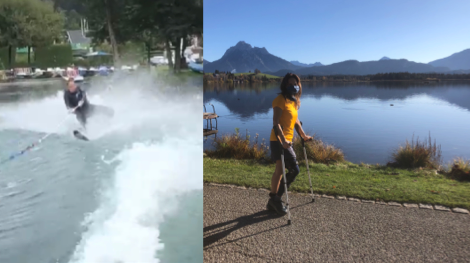What you can learn from ultrarunning to build resilience in the workplace:
How discipline is fun
How to train discipline
Discipline and self-confidence
Actionable steps and strategies for individuals to build resilience in the workplace.
Resilience is a key factor in overcoming crises in a way that conserves resources - both in the Ultratrail and in companies. So the interesting question is: can you train resilience? I can do this very well when running an ultra trail. A marathon or the necessary stamina for other sports is certainly enough. Regardless of your sporting discipline, you need the necessary discipline to achieve challenging goals and this can easily be trained in everyday working life. Wait a minute, I was just talking about resilience and now I'm talking about discipline. Discipline is like FC Bayern or corona rules: There are always fans and opponents. I didn't use to be a fan of discipline. Until I realized that eating a bar of chocolate can be just as disciplined as eating a salad.
Below you will find out why discipline is so important for resilience, how discipline is fun, how it can be practiced in everyday life (without spending extra time), how discipline and self-confidence are connected and what everyone can do to get the best out of unwanted, unplanned situations for themselves and those around them.

As I've already written, I wasn't a fan of discipline in the past. The word alone triggered inner rebellion in me. I often heard it when convincing arguments were lacking. Discipline follows rules and rules make sense when they are adapted to the goal. Take a close look in future to see if you come across rules that protect old rules without any sense. But beware: sometimes you don't immediately understand the connection to the goal. If you do, discipline can be really fun. Eating a bar of chocolate can be just as disciplining as eating a salad. You can also replace the chocolate with pizza if you prefer a hearty meal. Whether this is disciplined depends on your goal. I certainly wouldn't have got far at the Tor des Géants with salad. The photo below shows the dormitory in the second life base in Cogne. Fortunately, there are no pictures with odor transmission yet. It takes discipline to lie down here, let alone get up again after 45 minutes, go out into the cold night and continue walking.

Ultratrail running is a great way to train discipline, even without spending extra time. It's very simple: you just have to stick to your guidelines at all times. But it's not quite that simple.
When you go to bed at night, can you say with a clear conscience that you've done everything you set out to do for the day - every day?
Often you can't. And not because you were undisciplined, but because you once again took on far too much.
To avoid frustration on the way to your vision, it is important that you set yourself small, smart milestones in addition to a big, motivating goal. Your daily and weekly goals must be smart in the classic sense, i.e. achievable. There is a good technique for this: mark the most important activities for the day or week with a one. Priority 1 tasks must not be left undone! Then mark the priority 2 tasks and set yourself the target of completing 50% of them. Priority 3 tasks are only completed if there is still time after a break. Plan the quantity and scope of your priority 1 and priority 2 tasks deliberately conservatively, as something unexpected can always come up. And then consistently stick to the implementation, even if it gets stressful. Because if you always take on more than you can manage under realistic conditions, your subconscious will learn that you are not sticking to your own guidelines.
This brings me directly to the third point: who do you trust?
"What does it take for you to trust someone?", I ask in lectures or seminars and get the following answers in addition to the "time" factor: loyalty, commitment, reliability, honesty, authenticity, the trust of others, predictability. Even if the latter no longer has much to do with trust, it turns out that the above-mentioned "sticking to your own guidelines" fulfills a large part of the characteristics just mentioned. And while it is important for motivation to have an attractive vision (my definition of a SMART goal), daily and sub-goals must be smart in the classic sense, i.e. specific, measurable, achievable, realistic and time-bound.

By dividing the big goal, in my case a finish at the Tor des Géants, into many small stages, which you can achieve and implement with discipline and your method of time management, even in a busy and packed working day, you will gradually gain self-confidence and at the same time get closer to your goal. You don't run an ultra trail over 100, 200 or 300 kilometers, but from aid station to aid station, from checkpoint to checkpoint, and in difficult moments only the next step counts. And then another and another and another. The more challenging the situation, the smaller your sub-goals need to be so that they remain achievable.
Bonus point: master unexpected changes with discipline, resilience and self-confidence.
Whenever things go differently than desired or planned, this requires us to rethink and adapt to the new conditions. Social scientists and change managers explain the consistent reaction pattern to such changes using the well-known Kübler-Ross model, among other things. The model originally comes from the phases of coping with grief. The death of a loved one is certainly an extreme example of an unwanted change. Social scientists have also found comparable reaction patterns in other adjustment processes. I use this model to show you a way, based on my experience on the mountain and in business, that will enable you to move from the first to the last phase in a way that conserves resources:
- Phase 1: Shock and rejection
When the radiologist diagnosed a muscle tear with 7 cm retraction (distance to the insertion) by chance in October 2020, around seven weeks after an accident while water skiing that was declared a muscle fiber tear, I didn't want to admit it at first. However, I didn't have much time because I had to decide very quickly whether I wanted to have the operation. Normally, a muscle tear like this is operated on within a maximum of two days. Fortunately, I already had my Ultra-SAFE concept back then, which I gave a TEDX lecture about in 2018.

- Phase 2: Anger and blame
I could have blamed the orthopedic surgeon for the wrong diagnosis. Then four weeks would have passed, but not seven. As I've learned, "guilt" always refers to the past and that can't be changed anyway. Responsibility is much better. The doctor took responsibility by checking the new diagnosis and recommending me and the priority of this injury to a very good and experienced surgeon. And of course, I also took responsibility. I could have gone to the doctor or gone home immediately after the painful muscle cramp when I took my first step on the water ski slope. However, I was not aware of the option of tearing a muscle in my thigh, even though I am a qualified physiotherapist. So I didn't need to be angry with myself. - Phase 3: Negotiating
I sought three opinions from experts and received three answers: I should definitely have surgery immediately, versus the conviction that it was far too late for surgery. At this point, I was able to walk on flat terrain. I was unable to run or overcome differences in altitude. Dr. Björn Drews, now head of surgery at the Sankt Vinzenz Hospital in Pfronten, gave me an honest 50-50 assessment. It was similar to a negotiation, albeit my decision. "What would you advise your wife to do?" I asked him. "I would tell her to put her sporting ambitions on hold and not have surgery," he replied, adding, "but I can't advise you to do that." - Phase 4: Depression
Admittedly, I was not aware of the extent of the follow-up treatment, such as the relief with a maximum of 100 degrees of hip flexion (i.e. no normal sitting position, neither when eating nor on the restroom) for over 6 weeks and the very long way back. So I was happy with my decision to have the operation and mainly saw the chance to be able to walk up and down mountains again. - Phase 5: Acceptance
In this case, neither my mind nor my subconscious put up much resistance. Because it was clear to me that time, as in the Ultratrail race, would determine success or failure. That the demolition, like the sudden onset of winter at the beginning of September at the Tor des Géants, was unchangeable. When I was struggling with a swollen and very painful knee halfway through this race in 2019, it was a different story. Looking back, I wasted a lot of time and energy as a result. In the end, I managed to reach the finish line in 147 hours (non-stop) with a total of four and a half hours' sleep. However, it wasn't enough to qualify for the Tor des Glaciers, i.e. to finish in under 130 hours. When I worked my way back to ultratrail level for two years after my muscle tear - as a non-professional with various other commitments, three steps forward and two steps back, sometimes the other way around - the above-mentioned discipline and the resilience I had trained helped me significantly.
In 2023, I signed up for the TOR again with the question: How can I manage to be seventeen hours faster? With so little sleep from 2019 and with poorer muscular conditions than after optimal training with two healthy legs?
The answer: I have to manage to get to phase 4 (acceptance) when unexpected events occur without losing time or energy, not let myself be thrown off course, reorient myself briefly if necessary and accept everything that I cannot change as it is in order to make the best of it. A thunderstorm on the pass, hail in an open field, trails that turned into torrents, constant rain with a landslide, a broken pole and then the cold. I had the opportunity to practise. 127 hours 32 minutes and 35 seconds - to the finish.

More about Annabel Müller:
My sporting context is ultra trail running. In this endurance sport, you run distances of over 100 kilometers, mostly off the beaten track. I prefer to run in the mountains. My longest race: 349 km and 30,879 m in a maximum of 150 hours. These are the figures that the organizer gave for 2021 in the timetable, the year in which I wrote my book with egoth Verlag about this extraordinary ultra trail race. In contrast to the route, the kilometers vary from year to year. So do the challenges, because unlike the route, environmental influences and the weather can neither be planned nor influenced one hundred percent. And just as the terms VUKA or BANI describe our volatile, uncertain, complex and ambiguous world, there are always major deviations from the normal and unexpected extremes in ultratrail races. In a race like the Tor des Geánts, referred to by insiders as "the TOR", individual events only affect those who happen to be at the top of the pass during a thunderstorm, for example. Some challenges, such as a freezing snap at the beginning of September, are the same for everyone. This can also be easily transferred to life and business. However, people are shaped and resilient in different ways, which means that everyone perceives these influences differently. And while some people grow in the face of such a challenge, for others it can lead to resignation, anger, powerlessness and thoughts and behavior that are not very purposeful.
 Sports BusinessThe future of the bike industry: 6 innovative bike stores
Sports BusinessThe future of the bike industry: 6 innovative bike stores
- ISPO awards
- Mountain sports
- Bike
- Design
- Retail
- Fitness
- Health
- ISPO Job Market
- ISPO Munich
- ISPO Shanghai
- Running
- Brands
- Sustainability
- Olympia
- OutDoor
- Promotion
- Sports Business
- ISPO Textrends
- Triathlon
- Water sports
- Winter sports
- eSports
- SportsTech
- OutDoor by ISPO
- Heroes
- Transformation
- Sport Fashion
- Urban Culture
- Challenges of a CEO
- Trade fairs
- Sports
- Find the Balance
- Product reviews
- Newsletter Exclusive Area
- Magazine



